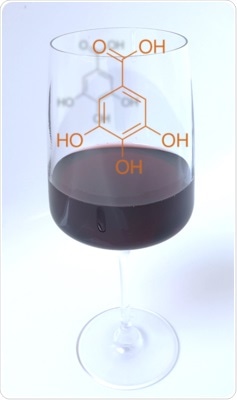Gallic acid, a secondary plant ingredient, is commonly seen in green tea or wine. An Austrian–German group of researchers headed by Veronika Somoza, recently discovered proof that gallic acid influences gastric acid release by driving a bitter receptor.

Gallic acid is a secondary plant ingredient found in wine or green tea. Image Credit: G. Olias/ Leibniz Institute for Food Systems Biology at the Technical University of Munich.
The observations offer novel foresight into the yet unknown functions of bitter receptors in interaction with taste-active food ingredients.
Veronika Somoza is deputy head of the Department of Physiological Chemistry at the Faculty of Chemistry, University of Vienna, and director of the Leibniz Institute for Food Systems Biology at the Technical University of Munich (LSB).
Veronika Somoza has been analyzing the physiological effects of taste-active substances found naturally in foods. This includes gallic acid, which offers red or white wine an astringent taste—it produces a slightly dry, rough sensation on the tongue and in the mouth. Certain researches also suggest that gallic acid tastes bitter, but is highly controversial.
Gallic acid interesting for research
This controversy makes gallic acid an interesting subject for analysis. There are many scientific pieces of research indicating that bitter substances and their receptors are vital for taste perception.
Bitter receptors are indeed found on the tongue. But other organs such as the stomach, the heart, or the lungs also have these taste receptors.”
Sonja Sterneder, Study First Author, Faculty of Chemistry, University of Vienna
Sonja Sterneder is pursuing her doctorate at the Faculty of Chemistry.
According to Sonja Sterneder, nutritional scientists say that the physiological functions carried out by them are not examined thoroughly. The recent research adds another piece of the puzzle on the overall functional picture of bitter compounds and their receptors.
Veronika Somoza and her group initially examined the bitterness of gallic acid comparing it with tap water employing sensory tests. They dissolved gallic acid in water and found that it tastes more bitter than tap water, and this was true even at a smaller dose (10 μM; 1.7 mg/L).
Likewise, the researchers also found that that the bitter taste is concentration-dependent and increases with increasing dose (up to 1,000 μM).
Plant compound stimulates acid secretion
The researchers later employed a cellular assay system to analyze the impact of gallic acid on gastric cells, which naturally have various kinds of bitter receptors. They discovered that the plant substance triggered gastric cells to release acid, irrespective of whether the scientists added it to the culture medium dissolved in water or red wine.
The researchers carried out extensive molecular biology investigations and found that gallic acid exerts this effect through the taste receptor TAS2R4. This speculation is endorsed by the computer-based structural analyses of the receptor and virtual docking experiments carried out by the Leibniz Institute.
Already our previous studies on the effects of caffeine indicate that the bitter receptor TAS2R43 is involved in the regulation of gastric acid secretion. Now we have found evidence for the involvement of another bitter receptor that is equally found on the tongue as well as on gastric cells.”
Veronika Somoza, Faculty of Chemistry, University of Vienna
Somoza’s group intends to continue the investigation of the molecular relationships between bitter substances and bitter receptors, aiming to enhance food digestibility.
Source:
Journal reference:
Sterneder, S., et al. (2021) Astringent Gallic Acid in Red Wine Regulates Mechanisms of Gastric Acid Secretion via Activation of Bitter Taste Sensing Receptor TAS2R4. Journal of Agricultural and Food Chemistry. doi.org/10.1021/acs.jafc.1c03061.